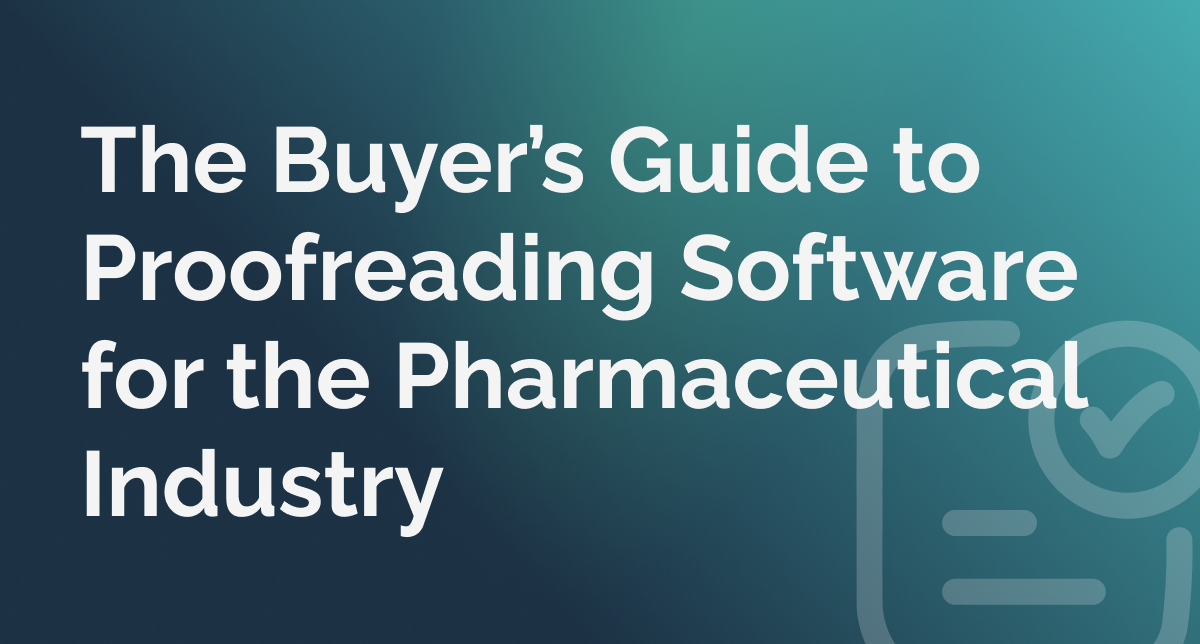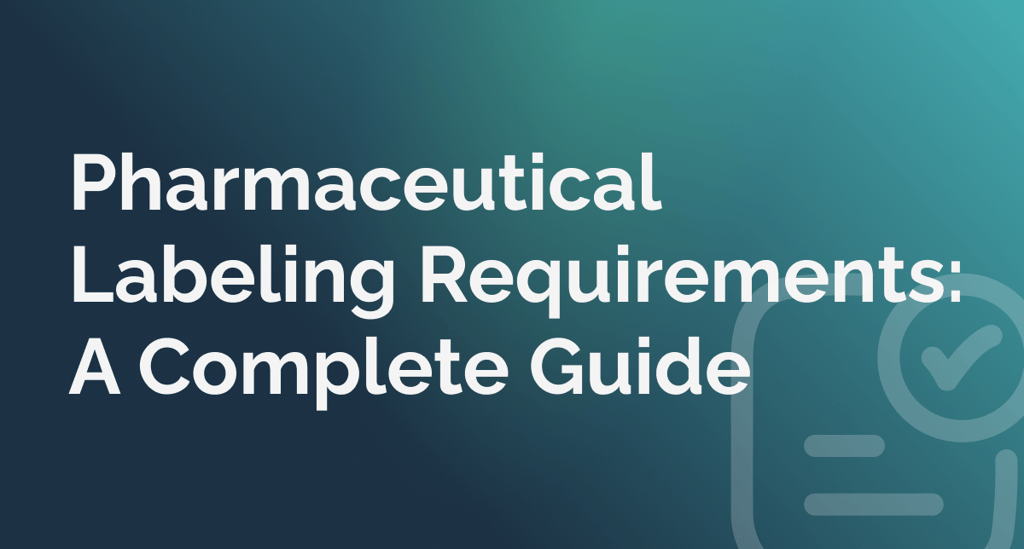In 2022, more than one in five FDA drug recalls stemmed from labeling or packaging errors.
Imagine a multilingual carton where a single warning line disappears in translation – production halts, regulators intervene, and thousands of printed packs are destroyed.
Proofreading errors aren’t cosmetic; they’re compliance failures.
As pharmaceutical portfolios expand across regions and languages, manual proofreading simply can’t keep up. This guide explains how automated proofreading software works, what to look for, and how to select a system that supports both accuracy and regulatory confidence.
1. Why Pharma Needs Automated Proofreading
Regulatory agencies such as the FDA, EMA, and MHRA expect verified, validated packaging processes. Typical labeling workflows, however, often involve numerous stakeholders and handoffs.
One product SKU can generate dozens of market-specific versions – different languages, pack sizes, and regulatory statements. Every new artwork multiplies the risk of an undetected error. A single global product may exist in 60 languages, each with unique dosage statements, controlled terms, and pictograms. Managing these versions manually often requires multiple proofing rounds and increases the likelihood of inconsistency.
- Manual comparison across PDFs or printed proofs introduces four main issues:
- Time pressure: approvals can take hours per file.
- Human variability: attention drops after repeated reviews.
- Limited traceability: comments are scattered across emails or PDFs.
- Scaling limits: more SKUs require more staff, not smarter processes.
Automated proofreading detects deviations instantly, produces auditable records, and maintains accuracy regardless of volume – helping teams meet cGMP and labeling-control expectations.
2. What Proofreading Software Actually Does
Proofreading platforms compare a “master” reference with a “sample” proof to confirm perfect alignment. In regulated environments, they typically handle:
- Text and layout comparison detects missing words, punctuation changes, or spacing shifts.
- Graphic and logo comparison: highlights pixel-level deviations.
- Barcode and Braille checks: verify readability and correct codes.
- Automated reporting: generates validation evidence for QA or regulatory audits.
Unlike office-grade tools, pharma-ready systems are validated, access-controlled, and audit-trail enabled to satisfy GxP requirements.
3. Key Features to Evaluate
Selecting proofreading software for a regulated industry isn’t only about usability or design polish – it’s fundamentally about regulatory defensibility.
Every function must withstand scrutiny, so compliance-focused capabilities should be prioritized. These are the “non-negotiables” that determine whether your system can be validated and accepted during audits.
The table below outlines the essential features any pharmaceutical or life-sciences organization should require before considering secondary efficiency tools.
Compliance-Critical
|
Feature |
Why It Matters |
What to Check |
|
Optical Character Recognition (OCR) |
Converts scanned artwork into text for accurate comparison. |
Supports complex fonts, diacritics, and multiple languages. |
|
Structured / XML Input |
Enables direct validation against regulatory data sources. |
Integrates with labeling or regulatory information systems. |
|
Audit Trail & Version History |
Documents every action for inspection readiness. |
21 CFR Part 11 and EU Annex 11 compliant records. |
|
Validation Package |
Confirms consistent performance. |
Vendor provides IQ/OQ/PQ documentation or templates. |
|
Security & Access Control |
Protects confidential labeling data. |
Role-based permissions and encryption. |
Once compliance requirements are met, attention can shift toward productivity and user efficiency – the features that turn a validated tool into a sustainable daily asset.
These enhancements won’t determine regulatory approval, but they dramatically influence reviewer satisfaction, turnaround time, and long-term ROI.
Productivity-Enhancing
|
Feature |
Why It Matters |
What to Check |
|
Automated Compliance Rules |
Detects missing dosage statements or symbols. |
Configurable to regional regulations. |
|
Specialized Dictionaries |
Recognizes INN drug names, Latin, and allergen terms. |
Customizable glossaries for therapeutic classes. |
|
Overlay / Split-Screen View |
Speeds up visual verification. |
Side-by-side alignment with zoom and layer toggles. |
|
Multi-Format Support |
Handles PDF, AI, Word, XML, TIFF. |
No need for manual conversions. |
|
Integration APIs |
Links to artwork or promo-review systems. |
Smooth data flow and single source of truth. |
|
|
|
|
A balanced platform blends both categories: compliance as the foundation, and productivity as the multiplier.
Organizations that prioritize one without the other often end up with either an over-engineered compliance tool or a fast but unvalidated system – neither of which delivers lasting value.
4. Quantifying the Benefits
Automation isn’t theoretical – its impact is measurable. A McKinsey analysis of smart QC environments found automation reduced lead times by 60-70 percent, and accelerated deviation closure by 90 percent.
In packaging workflows, similar technology cuts proofing cycles from roughly four hours to under twenty minutes, freeing Regulatory Affairs and QA reviewers for higher-value work.
Benefits cascade through the organization:
- Faster time-to-market.
- Consistent global labeling.
- Lower recall and reprint risk.
- Improved data integrity and inspection readiness.
5. Common Pitfalls When Selecting a Tool
Here are the five most common pitfalls when selecting a proofreading software fit for pharma.
- Assuming a tool is validatable. Regulators may reject results from unqualified software – even if comparisons were accurate.
- Relying on generic design-industry products without GxP documentation.
- Ignoring integration possibilities and therefore creating new silos.
- Choosing purely on cost rather than total lifecycle reliability.
- Overlooking user adoption – where cumbersome interfaces drive reviewers back to manual checks.
6. Manual vs. Automated Proofreading
Comparing manual and automated proofreading isn’t just about speed; it’s about process integrity. While human review remains essential for contextual judgment, automation provides the repeatability, auditability, and data integrity that regulators expect.
The table below summarizes how the two approaches differ across key operational and compliance dimensions.
|
Criterion |
Manual |
Automated |
|
Speed |
Hours or days |
Minutes |
|
Consistency |
Reviewer-dependent |
Algorithmic and repeatable |
|
Audit Trail |
Minimal |
Complete and timestamped |
|
Scalability |
Linear with staff |
Parallel and unlimited |
|
Regulatory Defensibility |
Weak evidence |
Validated, inspection-ready |
When presented side by side, it becomes clear that automation doesn’t replace expertise – it amplifies it.
By handling repetitive detection work, automated systems allow reviewers to focus on nuanced scientific and regulatory content that still requires human oversight.
7. Evaluating Vendors: Questions to Ask
Selecting a proofreading system is not just a software purchase – it’s a compliance partnership.
Even the best technical features will fall short if the vendor cannot demonstrate regulatory readiness, validation support, and a proven record in life-sciences environments.
During procurement, quality and IT teams should evaluate not only functionality but also the vendor’s ability to maintain validation over time, provide robust support, and align with your change-control and data-integrity requirements.
The checklist below outlines the essential topics to verify during the vendor selection process.
Each question helps determine whether a supplier truly understands the demands of regulated quality systems or merely offers a generic proofreading tool.
- Is the system GxP-compliant and 21 CFR Part 11/Annex 11-ready?
- What validation documentation is delivered?
- Does it integrate with our labeling or artwork-management platforms?
- How does it maintain validation through updates?
- What are the data-security measures (on-premises vs. cloud, encryption)?
- What training and support packages exist?
- Does the vendor have experience in a regulated industry and references from satisfied clients?
8. Implementation Best Practices
Approach rollout in three phases:
- Phase 1: Pilot
Select one brand or market to test performance and ROI. Validate outputs against manual results. - Phase 2: Scale
Integrate with upstream artwork and regulatory systems. Define KPIs: turnaround time, deviation rate, and reviewer hours saved. - Phase 3: Govern
Establish standard operating procedure (SOP), user roles, and periodic re-validation. Review metrics quarterly and document continuous improvement.
This phase-based approach embeds automation into everyday quality operations rather than treating it as a side project.
9. Choosing the Right Partner
Implementing proofreading automation is a long-term commitment; the vendor relationship extends well beyond installation.
When comparing suppliers, it helps to separate non-negotiable requirements from features that enhance performance but aren’t essential for regulatory acceptance.
Must-haves represent the capabilities that ensure the software can withstand an audit – things that protect patient safety, data integrity, and compliance.
Nice-to-Haves add flexibility, speed, or convenience. They often determine how well the system scales and how easily teams adopt it day to day, but lacking one shouldn’t invalidate a compliant solution.
The lists below outline both categories so buyers can prioritize confidently during evaluation.
Must-Haves:
- Proven record with pharmaceutical or medical-device clients.
- AI-enhanced OCR for multilingual content.
- XML/structured data compatibility.
- Comprehensive validation support and documentation.
- Active compliance updates reflecting new labeling rules.
Nice-to-Haves:
- User-friendly dashboards and analytics.
- Flexible deployment (cloud or on-premises).
- Responsive service-level agreements and global support coverage.
By viewing potential partners through both lenses – essential compliance and long-term usability – organizations can select a solution that not only passes inspection but also drives continuous efficiency gains.
Conclusion
As product portfolios expand and regulatory demands become more stringent, automated proofreading is no longer optional. It is the foundation for error-free labeling and sustainable compliance. By prioritizing validated performance, integration capability, and user adoption, pharmaceutical teams can transform proofreading from a bottleneck into a strategic advantage.




